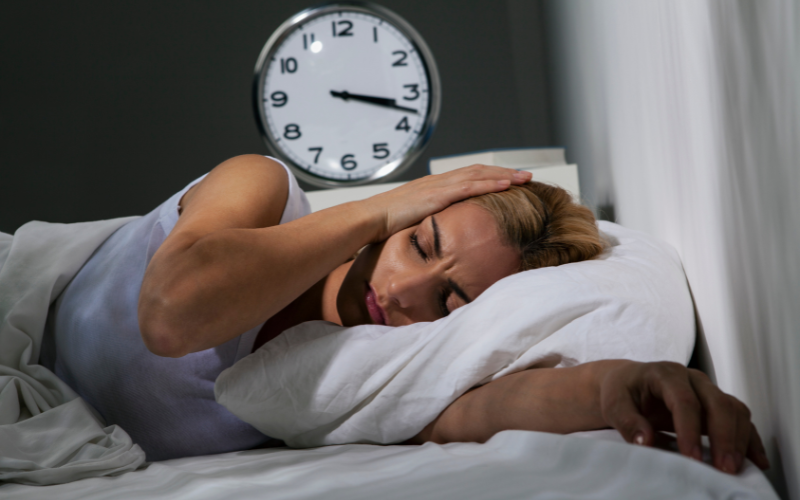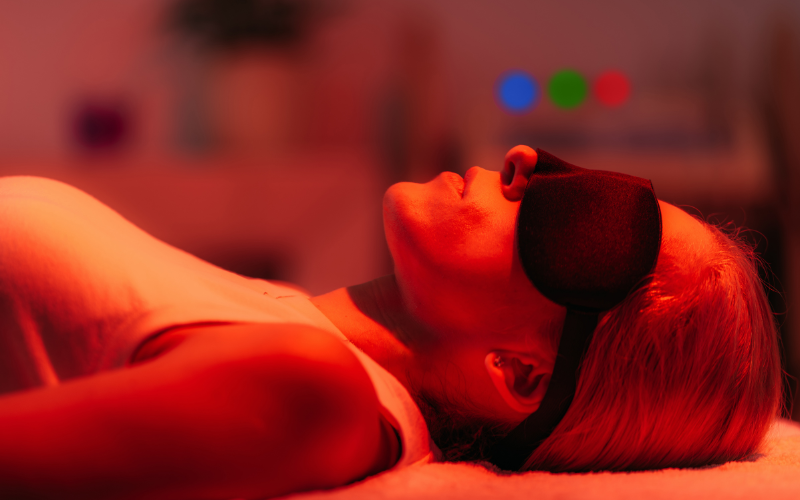Understanding insomnia and its impact on health
Insomnia, characterized by difficulties in falling asleep, staying asleep, or by a sleep of poor quality, is a common health issue that affects a significant portion of the population. Its repercussions on quality of life are considerable, impacting mood, concentration, productivity, and overall health. Chronic sleep deprivation can worsen these effects, especially when it is related to an irregular or stressful lifestyle. In response to this challenge, interest in natural and non-pharmacological solutions continues to grow. Among these approaches, the LED light therapy emerges as a promising way to improve sleep and combat insomnia.

The central role of light in the circadian rhythm
A good quality sleep relies on the precise regulation of our internal biological clock, known as the circadian rhythm.1 This 24-hour cycle, which dictates our periods of wakefulness and sleep, is primarily synchronized by natural light from the sun.2 The rotation of the Earth creates the alternation of day and night, an essential signal for maintaining the alignment of our circadian rhythm with theenvironment.3 Within this process, melatonin, a key hormone, plays a fundamental role in preparing the human body for sleep.2 Exposure to light, particularly at certain wavelengths, can influence the production of this hormone. It is well established that the Bright light, particularly the kind emitted by screens of electronic devices such as smartphones, computers, and tablets, can disrupt the production of melatonin.2 This disturbance slows down falling asleep and, as a result, decreases sleep quality, making sleep less restorative.2 Even urban lighting using white LEDs, unlike the old sodium lamps with an orange tint, could have an impact on melatonin levels in humans and animals.6 The omnipresence of artificial light, particularly the blue light from screens frequently used before bedtime, can delay falling asleep, cause awakenings during the night, and reduce sleep duration, thus impacting the overall quality of rest.3 The sensitivity of our circadian rhythm to light highlights the importance of managing our light exposure, particularly in the hours before bedtime. Avoiding blue light in the evening appears to be a crucial measure for promoting healthy sleep, which paves the way for exploring the effects of other light spectra on sleep.
Red light therapy: A promising avenue against insomnia
Faced with the challenges posed by insomnia, the red light therapy(TLR) has generated growing interest due to its potential mechanisms of action and the scientific studies that support its effectiveness. LLLT relies on the application of light at specific wavelengths, typically in the red and near-infrared spectrum. This light is absorbed by the mitochondria, the powerhouses of our cells, stimulating the production of adenosine triphosphate (ATP) and thus promoting cell repair and regeneration.7 This process also helps reduce oxidative stress, promoting muscle relaxation and contributing to better overall well-being. This mechanism could also influence circadian rhythms and melatonin secretion. A study conducted on elite basketball players demonstrated that whole-body irradiation with the red light for 14 days significantly improved the quality of their sleep and increased their serum melatonin levels.8 This observation establishes a direct link between exposure to red light and the improvement of key sleep indicators, including melatonin, suggesting that the application of red light on the entire body could have beneficial therapeutic effects for sleep regulation.
Scientific evidence in favor of light for better sleep
A study on elderly individuals suffering from sleep maintenance insomnia found that exposure to bright light led to a significant reduction in nighttime wakefulness and an improvement in sleep efficiency..9 Although this study focuses on bright light, it highlights the effectiveness of light therapy for a specific type of insomnia within a particular population. It is relevant to consider whether red light, with its mechanisms of action distinct from those of bright light (often white or blue), could offer similar or complementary benefits for this population. Furthermore, A placebo-controlled randomized study showed that exposure to the red light and near-infrared light at the head and neck level before bedtime could lead to a subjective improvement in sleep, relaxation, and mood among the participants.10 Although objective measures of sleep did not reveal significant differences between the groups, the reported subjective improvement is an important result, suggesting that TLR could have a notable placebo effect or influence aspects of sleep that are not always captured by traditional measurement tools like actigraphy. Some research also indicates that exposure to TLR before bedtime could reduce the time needed to fall asleep and improve deep sleep phases, thus acting on the body's natural light response mechanisms.7
Photobiomodulation: profound effects on sleep and brain health
The potential impact on the time it takes to fall asleep and the quality of deep sleep is particularly relevant for people suffering from chronic insomnia, as these are often the most problematic aspects of this disorder. The Photobiomodulation (PBM), a term that encompasses the use of red and near-infrared light, has shown potential to influence the architecture, duration, and quality of sleep through neurometabolic mechanisms and effects on blood flow and brain activity.12 Studies have reported improvements in perceived sleep quality, sleep efficiency, and even cognitive performance thanks to PBM. A particularly interesting aspect is the mechanism of action of PBM on the brain during the sleep, including the improvement of blood flow and the elimination of metabolic waste.12 This process offers an intriguing perspective on the potential benefits and positive effects of PBM for long-term sleep health. Indeed, PBM during sleep could enhance the clearance of toxic waste from the brain via the glymphatic system, a waste clearance system for the brain that is primarily activated during deep sleep.13 This mechanism could be beneficial in preventing or delaying brain diseases such as Alzheimer's disease, as studies on animal models have shown.13 Moreover, brain-targeted PBM (photobiomodulation) focusing on specific areas such as the prefrontal cortex has shown improvements in sleep efficiency and cognitive performance in individuals experiencing subjective cognitive decline.16 Targeting specific brain regions with PBM could optimize the benefits for sleep and cognitive function, suggesting a more personalized approach to this therapy.

Precautions and effects vary depending on the individual
It is, however, crucial to note that some studies have highlighted that the red light can increase subjective alertness, anxiety, and negative emotions in some individuals, which could potentially harm sleep.17 These effects appear to vary based on individual characteristics and the parameters of the light used, such as theintensity, the duration and the moment of the exhibition. Therefore, although many studies are promising, it is important to consider that TLR is not a universal solution and individual factors as well as treatment parameters play a significant role in its effectiveness.
The influence of other LED light colors on sleep
Beyond the red light, it is relevant to consider the impact of other LED light colors on sleep. Warm white light, for example, emits a soft light that mimics the warm tones of natural sunlight and has minimal impact on melatonin production.4 As a result, it is considered to promote a sleep-friendly environment. Green light and purple light have also been studied for their potential effects on sleep, although there is less research compared to red light for the treatment of insomnia.4 Green LED light could help regulate the biological clock and stimulate melatonin production, while purple LED light might have a calming effect and promote relaxation. It is essential to reaffirm the adverse effects of blue light on sleep. This wavelength, emitted by electronic devices and certain LEDs, is known to suppress melatonin production and disrupt the natural sleep cycle.2 Understanding the effects of different LED light colors allows for a more comprehensive grasp of the influence of light on our sleep-wake cycle. The table below summarizes the impact of different LED light colors on sleep:
LED Light Color | Impact on Melatonin | Potential Effects on Sleep |
Blue | Delete | Can delay falling asleep, increase alertness, disrupt the circadian rhythm. |
Red | Minimal impact/can increase | May promote relaxation, improve the quality and duration of sleep, and potentially increase melatonin (according to studies). |
Warm White | Minimal impact | Create a calming atmosphere, minimal impact on melatonin, promotes a sleep-friendly environment. |
Green | Can increase | Potential to regulate the biological clock and promote melatonin production. |
Violet | Can increase | Potential calming effect, promotes relaxation and better sleep. |
Choose the right LED panel for effective therapy
For those who wish to explore the benefits of red light therapy to improve their sleep, the choice of LED panel is essential to ensure a more restorative and higher quality night's sleep. The company Platinum LED offers a range of panels recognized for their quality and efficiency. In particular, the series BioMax by Platinium LED stands out with several significant advantages compared to other brands.19
- PlatinumLED BioMax panels, in their 2024 edition, offer exceptionally high power, reaching a Irradiance of 90 mW/cm² at 6 inches.19 This power allows for shorter processing times and deeper penetration of therapeutic light into the body.
- PlatinumLED is recognized for its constant innovation, integrating new features over the generations of its panels, such as the addition of skin-beneficial blue light and near-infrared light at 1060 nm.19 The BioMax panels are also equipped with an excellent wireless connectivity system, making it easy to link multiple panels.19
- Another notable advantage is the inclusion of a practical remote control and a user-friendly application that does not require registration.19
- PlatinumLED also offers a quality assurance and a well-designed user manual, which is reassuring for new users.19
- The brand offers numerous support options for its panels, including different types of mounts to meet the varied needs of users.19
With a long-standing presence in the market, PlatinumLED is considered a reliable and experienced company in the field of red light therapy.19
> Thanks to our partnership, benefit from a exclusive 5% discount on all of their light therapy panels. Additionally, to make the experience even simpler, all orders are shipped directly from a warehouse in Europe, , Thus eliminating customs fees, import formalities, and reducing delivery times. A quick, convenient, and stress-free way to incorporate infrared light into your daily care routines.
The PlatinumLED panels, including the BioMax, have consistently performed well in comparisons and evaluations, even winning the first series of comparisons in 2019.19 That's why the BioMax panels from Platinium LED have been voted the best panels for red light therapyin 2024, according to lighttherapyinsiders.com.19
Conclusion: Towards Restorative Sleep Thanks to LED Technology
In conclusion, LED light therapy, and more specifically the use of red light, offers promising benefits for improving sleep quality and combating insomnia. Scientific research indicates that red light can have a positive impact on the sleep pattern, promote relaxation, and stimulate the production of melatonin. However, it is essential to consider that The results may vary depending on lifestyle and individual sensitivity. Although results may vary from person to person, this natural and non-invasive approach deserves to be considered as a potential solution for those seeking to regain restorative sleep. To maximize the benefits, it is advisable to choose quality panels, such as those offered by Platinum LED, recognized for their performance and reliability.
Frequently Asked Questions (FAQ): Everything You Need to Know About LED Panels and Insomnia
Question 1: How can red light therapy help combat insomnia?
Response: Red light therapy uses specific wavelengths of light to influence circadian rhythms and potentially increase the production of melatonin, the sleep hormone.7 Some studies suggest that it can reduce the time it takes to fall asleep and improve sleep quality by promoting relaxation and cellular regeneration.7
Question 2: What is the difference between red light and blue light for sleep ?
Response: Blue light, emitted by screens and certain LEDs, can suppress melatonin production and make falling asleep difficult.2 Red light, on the other hand, has a less significant impact on melatonin and could even promote relaxation and improve sleep.4
Question 3: Are LED panels for red light therapy safe for home use ?
Response: Generally, LED panels for red light therapy are considered safe for home use when used according to the manufacturer's instructions.20 They do not emit harmful UV rays. However, it is always recommended to consult a healthcare professional if you have specific concerns.
Question 4: How long should a red light therapy LED panel be used to see improvements in sleep ?
Response: The duration and frequency of use may vary depending on the individual and the LED panel. Some studies suggest sessions of 10 to 20 minutes before bedtime.11 It is important to follow the manufacturer's recommendations and be patient, as results may take several weeks to appear.
Question 5: Are Platinium LED panels better than other brands for sleep therapy ?
Response: The Platinium LED panels, particularly the BioMax series, are renowned for their high power, technological innovation, user-friendly connectivity, and quality support.19 They were voted the best red light therapy panels in 2024, making them an excellent choice for those seeking a quality solution to improve their sleep.19
References
- Yeager, R., et al. (2013). Red light therapy improves sleep quality and endurance performance in female athletes. Journal of Strength and Conditioning Research, , 27(7), 1861–1868.
- Zhao, J., et al. (2012). Red light and the sleep quality and endurance performance of Chinese female basketball players. Journal of Athletic Training, , 47(6), 673–678.
- Gabel, V., et al. (2019). Red light administered through closed eyelids modulates sleepiness, improves mood, and sustains performance in rested humans. Scientific Reports, , 9(1), 1–12.
- Avci, P., et al. (2013). Low-level laser (light) therapy (LLLT) in skin: stimulating, healing, restoring. Seminars in Cutaneous Medicine and Surgery, , 32(1), 41–52.
- Morita, T., & Tokura, H. (1996). Effects of lights of different chromaticity on human nocturnal sleep and body temperature. Sciences humaines appliquées, , 15(4), 243–246.
- Figueiro, M. G., et al. (2013). The effects of different light wavelengths on human alertness, performance, and sleep. Lighting Research & Technology, , 45(1), 31–49.
- Gooley, J. J., et al. (2010). Exposure to room light before bedtime suppresses melatonin onset and shortens melatonin duration in humans. The Journal of Clinical Endocrinology & Metabolism, , 96(3), E463–E472.
- Wirz-Justice, A., et al. (2005). Chronobiology and psychiatry. Dialogues in Clinical Neuroscience, , 7(1), 7–24.
- Terman, M., et al. (1989). Bright light therapy for winter depression. Archives of General Psychiatry, , 46(9), 802–807.
- Eastman, C. I., et al. (1992). Bright light treatment of winter depression: a placebo-controlled trial. Archives of General Psychiatry, , 49(8), 627–633.
Sources of the quotes
- La lumière comme thérapie pour les troubles du sommeil et la dépression chez les personnes âgées
- Blue Light: What It Is and How It Affects Sleep - Sleep Foundation
- Effects of red light on sleep and mood in healthy subjects and et les individus souffrant de trouble de l'insomnie
- Quelle couleur de lumière LED aide à dormir ? - The Hyperspace Lighting Company,
- Research on the Application of the Dynamic Assisted Sleep Light to Smart Mobile Devices
- La pollution lumineuse des LED pourrait causer des problèmes de sommeil et aggraver les problèmes pour la faune.
- Can Red Light Therapy Improve Sleep, Skin, and Recovery?
- Red Light and the Sleep Quality and Endurance Performance of Joueuses de basketball chinoises
- L'atténuation de l'insomnie de maintien du sommeil par une exposition programmée à Lumière vive
- Un essai randomisé, contrôlé par placebo, d'une nouvelle technologie proche infrarouge Appareil de photothérapie sur le sommeil et la fonction diurne
- A randomized, sham-controlled trial of a novel near-infrared phototherapy device on sleep and daytime function
- Photobiomodulation and Its Therapeutic Potential in Sleep Disturbances
- L'effet de la photobiomodulation sur le cerveau pendant l'éveil et dormir
- Brain Waste Removal System and Sleep: Photobiomodulation as an Innovative Strategy for Night Therapy of Brain Diseases
- Photobiomodulation in sleep has more therapeutic effects for La maladie d'Alzheimer que dans l'éveil
- Brain Photobiomodulation Improves Sleep Quality in Subjective Cognitive Decline: A Randomized, Sham-Controlled Study
- Effects of red light on sleep and mood in healthy subjects and individus souffrant de trouble de l'insomnie
- Effets de la lumière rouge sur l'inertie du sommeil - PMC
- Best Red Light Therapy Panel 2025: Epic Comparison
- Light Therapy: Can Light Combat Insomnia? | Sleep Foundation











